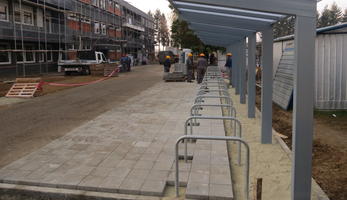Zero CO2 University Campus
Thematic areas
Behavioural change & mobility management
Summary
In Koprivnica a “living laboratory” has been established at the new university campus, aiming for a zero CO2 emission campus by implementing e-vehicles for personal and freight transport, a virtual mobility centre and infrastructure for zero emission vehicles. Some of the 5,000 students themselves were also involved in the development and evaluation of the measures.
Implementing sustainable mobility
Koprivnica has a vision to be the city of knowledge and this has already been reflected i the city’s education policies and in the establishment of best possible conditions in the education institutions and facilities. Koprivnica is home to three of the country’s biggest secondary schools with over 2,500 students and to a local department of the Graduate School of Economy of the University of Zagreb.
In the first five-year period 1,500 students were enrolled, while a student population of 5,000 was the plan for the first ten years. The newly-founded university aimed at providing specialized curricula connected to various aspects of sustainable development. The ambitious plan include a complete reconstruction of the former Croatian army barracks into a zero CO2 emission site with an integrated fully sustainable mobility system, including electric vehicles, local train and electric bus connection, campus bicycles and pedelecs.
The university campus is a testing ground for various means of zero emission transport, including electric cars and pedelecs and offering innovative transport services such as campus bikes, demand responsive e-buses and an innovative car-sharing scheme as well as the intermodal connection to the modernised international railway.
The main objectives of this measure were to:
- Develop a sustainable mobility plan for the new university campusplan the use of zero emission vehicles for personal and freight transport corresponding to the concept of zero emission university campus
- Plan infrastructure for zero emission vehicles and soft mobility modes
- Develop the concept of campus bike
- Develop the concept of the virtual mobility centre for the university campus
- Promote sustainable transport region-wide
- Increase public awareness of better transport solutions
- Plan the sustainable mobility options for 5,000 new young residents of the city
- Develop a competence centre for SUMP
Progress
The City of Koprivnica has been recognized as regional mobility champion with a number of independently developed and systematically implemented measures and on-going mobility projects. This measure further improved the transport sustainability and provided an opportunity for training of future specialists who would work on transport sustainability issues in the wider region.
As signatory of the Covenant of Mayors, Koprivnica is aiming at ambitious reductions of CO2 emissions in public and private buildings as well as in transport. The first passive estate for social housing is currently being constructed, with 7 passive blocks of flats, while private investments in passive house building are subsidised through the City council’s Declaration of Passivity programme.
The attractive campus grounds and new university programme is expected to provide the basis for the new city development, with young students, staff members and their families increasing the number of Koprivnica citizens by 25% and providing a basis for local business development. The sustainability of transport will further improve the image of the city and contribute to its attractiveness and quality of life.
Planning & preparation
- Assessment of local conditions and definition and identification of stakeholders
- Production a work plan and definition of resources
- Study examples of best-practice
- Preparation of a plan for the inclusion of campus transport means into the future intermodal public transport
Implementation & demonstration
- Developed mobility plan in connection with the planning of the campus area
- Planned infrastructure for zero emission vehicles and soft mobility modes
- Designed mobility management scheme with developers of campus buildings
- Designed electric vehicles charging station
- Designed campus rental bike system and brought in line tehnical requirement of the Kampus rental system with the City's bike sharing system
- Designed and constructed facilities for electric vehicles
- Designed virtual mobility centre
- Establishment of information portal for students and campus staff
- Elelectric vehicles for personal transport and freight delivery in the campus grounds tested
Outcomes
The implemented solutions are not only intended to strongly influence the behaviour of university students but also contribute to building permanent life-long mobility awareness and influence choices of mobility means in the future. The same also refers to university staff members and their families as well as other employees of the new campus. The innovative technology was developed on campus grounds, in cooperation with other universities and specialized national and international institutions. This makes the new university a truly innovative centre of sustainable mobility, both in mobility planning and in the development of innovative mobility solutions.
Tangible outputs:
- Developed mobility plan for the university campus
- Implementation of an e-bike terminal with 10 pedelecs, fully integrated with the city’s bike sharing scheme
- Implementation of a virtual mobility centre for students and staff with information about timetables and other information about public transport and bicycle schemes
- Testing area for the use of new sustainable mobility options defined
- Campus e-bike system developed
- Infrastructure for electric vehicles implemented
Expected outcomes in the short to medium term:
- Developed sustainable mobility plan
- Mobility management plan with designers of campus facilities
- Design of electric vehicles charging station
- Design of campus rental bike system
- Design of virtual mobility centre
Expected outcomes in the mid to long term:
- Construction of facilities for electric vehicles
- Construction of innovative shelters for bicycles and pedelecs
- Virtual mobility centre developed
- Established information portal for students and campus staff
- Test of the use of electric vehicles for personal transport and freight delivery in the campus grounds









